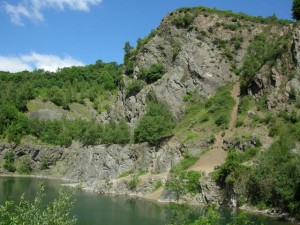
Gullet Quarry, Malvern Hills
Geological overview
The main face shows a cross-section through most of the Preambrian rock that makes up the core of the Hills. The face itself exhibits many rock types including diorite, granite, gneiss, schist, pegmatite and dolerite. The evidence of the complex history of earth movement which formed the Hills can be seen by multiple joints, fractures, faults and shears, which make identifying changes in rock types difficult. Within these features mineral deposits such as haematite, calcite and epidote can be found.
The nature of the contact between the Malverns Complex and the overlying Silurian rocks has been a matter of debate for many years, although the balance of opinion now favours an unconformable relationship. A fault which cuts the Silurian sequence and extends into the Malverns Complex below is probably of Upper Carboniferous age, associated with the uplift of the hills.
Location
Eastnor, Malvern Hills, Herefordshire; Grid Reference: SO 7616 3813
Access
Open access
Geological Age
Precambrian – Malverns Complex
Silurian – May Hill Sandstone Group
Rock Types
Sedimentary – donglomerate; sandstone; limestone; shale
Igneous – dolerite; granite;
Metamorphic – gneiss; schist
Features
Dykes
Veining
Altered doleritic rocks
Gneissose foliation
Shearing
Faulting area structural geology; faulting;
Sedimentary structures;
Fossils
Variable lithologies
Area structural geology
Interpretation
Interpretation board
‘Explore’ Malvern Hills 2 guide



